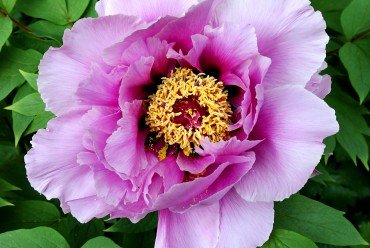
The natural elements can be cruel. The fabulous, 10-inch (25-cm) blossoms on my mauve tree peony (Paeonia suffruticosa, Zone 5) are all smashed up, the result of an unpredicted heavy rain one recent evening. That was certainly a low blow to a gardener who, with a little advance notice, would gladly have stood there holding an umbrella over the blooms during the deluge. That would be easy gratitude for the pleasure they give me.
The flowers of tree peonies are startling huge and beautiful (and some are deeply scented), and their foliage remains attractive all season. The Irish gardener and horticultural writer William Robinson (1838-1935) grew many tree peonies, and suggested spotting them throughout perennial borders, or giving them a display bed of their own with a low ruffle of long-blooming perennials such as the little Carpathian bellflower (Campanula carpatica, Zone 3) surrounding them.
Tree peonies are small shrubs with woody stems that remain through winter. They’re usually self-supporting, although it’s been my experience that they get a bit lax and floppy when grown in low light and sometimes require staking. Tree peonies will flower in part shade, but more blossoms and stiffer stems are produced in sunny locations. They’re grafted on rootstocks of species herbaceous peonies, and occasionally the rootstock sends up a stem with leaves noticeably different from the tree peony. Cut out any rogue stems coming from below ground as low as possible, otherwise they can overwhelm the grafted plant above.
I also have several herbaceous peonies inherited with my garden, including double pink ‘Sarah Bernhardt’ and single white ‘Jan Van Leeuwen’ with a centre of thick yellow stamens (and delicious lemon scent). When the flowers are finished, their foliage takes up more space than I want to give them. I know the leaves are working all summer to store energy for next year’s flowers, but I don’t think it hurts to eliminate up to 25 per cent of the stems, cutting from the outer edges of the plant, to reduce its bulk. So far this method of controlling their size hasn’t reduced flowering.
A new category is intersectional peonies (sometimes referred to as Itoh peonies), the result of crossing herbaceous and tree peonies. Intersectional peonies die to the ground in winter, but their flowers and foliage are quite like tree peonies, and colour choices include yellow, unknown in herbaceous peonies. This innovative breed of peony strikes me as a good opportunity to begin a new collection (My acquisitive spirit perks up!), and I think they would make a superb double-bordered peony walk. Once the flowers are finished, the ornamental foliage would continue to enhance both sides of a pathway for the rest of the growing season. This seems the ideal combination of peony attributes, and my compliments to the clever plant breeder who thought of this.
Time to prune lilacs

The lilacs have been terrific this year, their flowers lasting so well in the cool, moist spring conditions. Lilac season begins with the early Syringa x hyacinthiflora cultivars, including Canadian-bred lavender-pink ‘Asessippi’ and violet-purple ‘Pocahontas’. These are followed by the S. vulgaris French hybrids, a large category with familiar named plants like purple ‘Agincourt Beauty’ and white ‘Madame Lemoine’. The latest to flower are the Preston lilacs (S. x prestoniae), another group of plants bred in Canada, and including my bright pink ‘Miss Canada’, currently blooming in the front garden. The Preston lilacs are particularly vigorous shrubs, with large flower trusses, and a distinct scent of privet inherited from ancient genes. If you’re expecting the usual lilac perfume, the Preston plants will surprise you.
The French hybrid lilacs in my back garden have become quite leggy, and some have reached 15 feet (4.5 m) in height, with all the flowers coming at the top. This is very nice for my neighbour’s second-floor balcony, but it’s not as satisfying for me down below in the garden. It’s time to lower the height on these plants, and the pruning must be done immediately after flowering is finished to avoid sacrificing next year’s flower buds. There’s no time to waste!
The basic approach is simple, and focuses on rejuvenating the plants by removing up to one-third of the stems each year, for three years, and stimulating new stems that will eventually carry flowers. Lilacs bloom best on younger wood, so I’ll begin with the oldest stems that have grown more than two inches (5 cm) thick. I’ll also take out anything that’s broken, or weak and twiggy. Lilacs react quickly to pruning, sending up suckers from the base. That’s a good thing, as the strongest of these will be the ones to save and develop into a well-shaped shrub. I’ll save three or four of the best suckers, and eliminate the rest. I’m aiming for a plant about eight feet (2.5 m) tall, with flowers blooming at all levels. It may take a few years to bring these tall lilacs back to a more manageable size, and the strong new sprouts from underground will bloom in three to four years. Lilacs need shaping every year to ensure there is always vigorous new wood developing, while older stems are removed. That’s the way to disappoint the neighbours and keep lilacs blooming where I can see them.
Thanks for visiting at Making a Garden.









I live in Zone 3a (Winnipeg), and I have about 7 or 8 (I keep losing count) tree peonies as well as many Itohs. I haven’t covered Hana Kisoi in over 10 years and it keeps on flowering, year after year. I covered a couple of the newer ones and it makes a slight difference – fewer flowers. I used cardboard boxes and lots of peat moss, almost to the top of the tree. Worked like a charm!
Hi David (June 18),
Tree peonies are hardy to Zone 5, and that will make it almost impossible for them to keep live wood through a Zone 3 winter. I don’t think there’s any amount of wrapping or mulching that will help. I have one idea, and that is to grow them in large containers that can be moved into an unheated garage for winter storage. You could put them into the garage in November, and take them back outside in May. While in the garage, make sure their soil is moist and drape a plastic bag over each plant, being sure to leave the bottom open for air circulation. This idea involves some heavy lifting, but the peonies could live permanently in the containers, and probably would bloom each spring. It’s worth an experiment!– Judith
I have two bush peonies; one that has been in my garden 4 yrs and one for 5 yrs. ( My zone is 3a ) They both winter-kill to the ground every year but seem to have very healthy growth each spring. The herbaceous roots are not sprouting; it is the bush that’s growing. The new growth is wood and it does branch while growing.
In all this time I’ve only ever gotten one flower. It was on the second one planted. After three years I got one flower that lasted three days. But what a flower!
How can I keep them from the winter damage so as to grow bushes greater than 30″ tall and get consistent flowering?
Hi Kim (June 15),
It’s difficult to predict when a lilac will bloom –some are precocious early starters, while others are reluctant and can wait several years before blooming. The size of the shrub may be an indicator; when your plants have reached a 40 inches (1 m) in height, you might begin to see flowers. However, no guarantees on that. Of course, it’s worth waiting for!
— Judith
Thanks Judith, I will try that. How long does it normally take to get blooms?
Hi Kim (June 9),
Probably the most important factor in raising healthy lilacs is to be sure they have good drainage. Lilacs need regular irrigation, but won’t tolerate standing in saturated soil.
Hoping for blooms next year is perhaps a little optimistic, but you might get lucky. If you want to give the lilacs some encouragement, try using a liquid transplant fertilizer solution with the analysis 5-15-5, and containing 0.003 % IBA (indole-3-butyric acid), watered into the root zone. The IBA is a root stimulator (similar to the powder used to root leaf cuttings), and will encourage the plants to make new roots, which then will result in top growth on the plants. You can purchase the transplant solution at a garden centre, and use it in spring, and up to the end of July on plants already established in the ground. I wouldn’t use it after July, for fear of stimulating late growth that wouldn’t have time to harden before frost.
Good luck, and I think you’ll be enjoying lilac blooms before too long.
Hi Judith, I have new lilacs, they are 2 yrs old and struggled a bit getting started. Four of the original 5 survived and they are about 18 inches tall. I haven’t had any flowers yet. Is there anything special I need to do for them to help them and maybe get flowers next year?
Thanks,
Kim